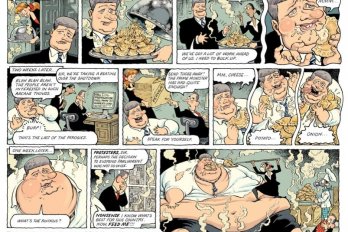Isaw her only once, ten days before the earthquake. She held the door open for us, for my friend Phil and me, as we wrestled his couch into his new apartment building on Ottawa’s Fairmont Avenue. Blond hair curling out from under her toque, funky glasses—I would have remembered that even without seeing her picture on the news and in the papers. She followed us up the stairs to the third floor. Phil was moving into apartment number 11. She lived in number 10, the girl across the hall.
She kicked off her Sorels and placed them next to the wooden shoe rack outside her door. The rack was full, eight pairs of shoes in neat rows, with more scattered on the floor around it, and now her boots. She said something about going shopping. “I hope you can find a pair of shoes to wear,” Phil said. She laughed and disappeared inside her apartment.
That was the last time I saw her, but Phil got to know her a little better. The day after he moved in, she came over with a banana muffin she had baked, and they shared hot chocolate. She had lived in number 10 for six years, and her friend had lived in number 11. She talked about how weird it was to see the apartment with someone else’s stuff in it. Then she saw Phil’s bike in the corner and told him she was planning on training for a half-Ironman this summer, but she was nervous about the swim.
Death in Digital
Social networking from beyond the grave
Jack Dylan
The idea of mediums, vectors through which people hope to communicate with the dead, has existed for millennia. Since the third century AD, variations on the modern Ouija board have ostensibly opened pathways between our world and the spirit realm. In nautical folklore, the Flying Dutchman was a ghost ship capable of relaying messages to the deceased. More recently, TV mediums like John Edward have ghost-whispered for audiences in the millions. And now social networking websites help us connect with the dead. A new Facebook application, Follow Me after I Die, allows users to stay connected from beyond the grave: “Leave your friends and family a Final Facebook status message after you’ve passed on… Fill out the form below and we’ll post your ‘after-life status message’ to your Facebook when you’ve gone to a ‘better place.’”
Later, Phil ran into her in the laundry room. “Have you ever been to Haiti? ” she asked. Phil said it wasn’t high on his list of places to visit. “I’m going there for work next week,” she said. Phil backpedalled: “I’m sure it will be fine.”
He knocked on her door that afternoon to borrow a can opener and some brown sugar. He was making a coconut curry. He offered to share it with her, but once he’d cooked it he decided it wasn’t very good. He made up his mind to share the next batch with her instead.
Two days later, on January 12, she flew to Port-au-Prince on Air Canada’s weekly flight from Montreal. She sent an email to her work to say she had arrived at the Hôtel Montana, safe and sound. Within the hour, the earthquake struck and the hotel fell down.
At first, Phil’s worry came in little waves, a distant hum. Then came knots and sleeplessness. Her picture appeared on a Facebook page dedicated to finding lost hotel guests, alongside university students from Florida and a Uruguayan man and his three-year-old son. Her friends and family hoped she was simply unable to make contact or was trapped but would survive. After all, the shoes outside her apartment were small, only size six, but they were scrambling shoes, made by North Face, Merrell, Salomon. She almost certainly had a membership at Mountain Equipment Co-op. She was built to last.
The days passed. Her photograph continued to circulate. Her uncle made a plea on TV. People were pulled out of the hotel, people who had been caught in the lobby or in the elevator shaft, but not her. Each morning, Phil left his apartment and saw her shoes, and each night he came home and saw them again.
A week after the earthquake, her friends gathered for a nighttime vigil in the park across the street from her building. Phil walked over, his boots crunching in the snow. He could see her apartment from the park; the windows were dark. Her friends lit candles and talked about the party they were going to have when she came home. Everyone tried to keep brave faces. “I bet her feet are warmer than ours right now,” someone said. But the park was surrounded by an old stone wall that had recently been knocked down into piles, and it was hard not to think of the weight of those stones.
Phil sat in his new apartment and ate what was left of his coconut curry, the last of his hope vanishing with it. Eleven days after the earthquake, rescuers pulled a “miracle survivor” out of the rubble. Telethons raised money. Orphans arrived at the airport twenty minutes from Fairmont Avenue wrapped in blue blankets. World leaders gathered in Montreal to talk about how to save Haiti. It felt like a long time since Canadians were so deeply affected by a tragedy so far away. Maybe it was because the degrees of separation were smaller this time, the gap between us and them sometimes no wider than a hallway.
It’s January 26. The streets are wet. Her shoes are still there, outside her door. Tonight her friends opened it for the first time since she left. They just learned that her body had been found, identified by the iron ring on her little finger. Soon they will have to pack up her stuff, and someone else’s stuff will be moved in. Other traces of her will last longer: emails from her left undeleted, her voice still answering her phone.
It seems as though we should be able to conjure her out of those fragments of a former life, out of code and objects-turned-artifacts. A million tiny threads have been tied between them and even our most insignificant memories of her—the size of her feet, the kinds of muffins she baked—the same threads that have been tied between number 10 and the ruins of Port-au-Prince. She held open the door for me. Phil made a joke about her shoes in the hallway. She laughed, and then she disappeared.




